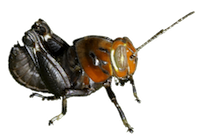Family (Alpha): ACRIDIDAE GRYLLACRIDIDAE GRYLLIDAE GRYLLOTALPIDAE RHAPHIDOPHORIDAE ROMALEIDAE TETRIGIDAE TETTIGONIIDAE TRIDACTYLIDAE
View Gryllidae Members:
Acheta domesticus Anurogryllus arboreus Gryllus unidentified species Gryllus firmus Gryllus fultoni Gryllus pennsylvanicus Gryllus pennsylvanicus/veletis Gryllus pennsylvanicus-veletis Gryllus rubens Gryllus veletis Miogryllus verticalis Velarifictorus micado Hapithus agitator Orocharis unidentified species Orocharis luteolira Orocharis saltator Cycloptilum unidentified species Cycloptilum bidens Cycloptilum pigrum Cycloptilum slossoni Cycloptilum tardum Cycloptilum trigonipalpum Cycloptilum velox Myrmecophilus pergandei Allonemobius allardi Allonemobius fultoni Allonemobius griseus griseus Allonemobius griseus funeralis Allonemobius maculatus Allonemobius socius Allonemobius sparsalsus Allonemobius tinnulus Allonemobius walkeri Allonemobius unidentified species Eunemobius carolinus Eunemobius confusus Eunemobius melodius Eunemobius unidentified species Neonemobius cubensis Neonemobius palustris Neonemobius variegatus Pictonemobius ambitiosus complex Pictonemobius ambitiosus Pictonemobius hubbelli Nemobiinae unidentified species Oecanthus unidentified species Oecanthus celerinictus Oecanthus exclamationis Oecanthus fultoni Oecanthus latipennis Oecanthus nigricornis Oecanthus niveus Oecanthus pini Oecanthus quadripunctatus Neoxabea bipunctata Phyllopalpus pulchellus Anaxipha delicatula Anaxipha exigua Anaxipha litarena Anaxipha rosamacula Anaxipha thomasi Anaxipha tinnula Anaxipha tinnulacita Anaxipha tinnulenta Anaxipha vernalis Anaxipha new species near vernalis Anaxipha unidentified species Cyrtoxipha columbiana Falcicula hebardi Gryllidae unidentified species NC Records
Anaxipha delicatula (Scudder, 1878) - Chirping Trig
Taxonomy
Family: Gryllidae
Subfamily: TrigonidiinaeTribe: TrigonidiiniComments: One of thirteen species in this genus that occur in North America north of Mexico (SINA, 2017); nine of which have been recorded in North Carolina. Delicatula is part of the Delicatula Species Group, which also includes A. vernalis.Species Status: Fulton (1951, 1956) treated both vernalis and delicatula under the name delicatula. In splitting the two into separate species, Walker and Funk (2014) assigned all of Fulton's records for delicatula to vernalis, except for one series from Carolina Beach.
Identification
Field Guide Descriptions: Online Photographs: SINA, Google Images ,
iNaturalist , GBIF Technical Description, Adults/Nymphs: Walker and Funk (2014)SINA 618a.htm Comments: A very small, brown Trig. Unlike most members of the Exigua Group, it lacks a stripe on the lateral face of the femur (Walker and Funk, 2014). Structural features -- particularly the number of pegs on the stridulatory file -- must be examined to identify this species. This species is very similar in appearance and in genitalia to delicatula but they can be easily distinguished by their songs.Total Length [body plus wings; excludes ovipositor]: 6.2-6.8 mm, males; 4.8-6.7 mm, females (Walker and Funk, 2014)Structural Features: Stridulatory file with about 73 teeth (range 66-77); ovipositor 1.3-1.6 mm, ratio of length of hind femur to ovipositor 3.0-3.3. Long-winged forms can be common at lights.Singing Behavior: Songs consist of series of nearly regular short trills, rather than the continuous trills characteristic of vernalis. The within-trill pulse rate is about 79 pulses per second at 77 F (= 25°C), with the dominant frequency at 5.7 kHz. Anaxipha litarena -- which is found in the same tidewater areas at about the same season -- also has songs consisting of short trills, but with a slower pulse rate of about 66 syllables per sec at 77 F (25° C), but with a very similar dominant frequency at 5.9 kHz. Walker and Funk further distinguish these two species by characteristics of the pulse train (PT = trill): "in delicatula the PT rate is nearly always faster, the PT durations are usually shorter, and the PT intervals are relatively longer." They note, however, that "in Florida the PT phrasing seems always to be useful in separating the two species by ear but this may not be the case in coastal North Carolina." One specimen we recorded at Atlantic Beach had a pulse rate that fits delicatula (see song graph) but had relatively long trill durations and relatively short inter-trill intervals, both of which are a better match to litarena. Based on its association with a Spartina marsh, however, we have assigned it to delicatula.Diagnostic Song Parameters: Nymphal Stages and Development: Apparently undescribed but unlikely to be distinguishable from vernalis except by habitat
Distribution in North Carolina
County Map: Clicking on a county returns the records for the species in that county.
Adult Dates: Click on graph to enlarge
Habitats and Life History
Habitats: Occurs with tinnula in "in cordgrass marshes of coastal NC" (Walker and Funk, 2014); they also occur in "fresh water marshes, including lizardtail (Saururus) and cattails (Typha); on herbaceous undergrowth in riparian areas." Diet: Apparently unrecorded; possibly omnivorousObservation Methods: Singing males are most easily detected but they may also be captured using sweep nettingAbundance/Frequency: Adult Phenology: Walker and Funk (2014) give dates between June and September for populations north of Florida
Status in North Carolina
Natural Heritage Program Status: [W3]Natural Heritage Program Ranks: GNR SNR [S2S4]State Protection: Has no legal protection, although permits are required to collect it on state parks and other public landsComments: This species reaches the northern extent of its range in North Carolina and except possibly for the specimens from Corolla, our few records are mostly historic and one recent record is somewhat questionable in terms of its song characteristics. More surveys are needed to determine its current distribution and abundance.
Image Gallery for Anaxipha delicatula - Chirping Trig Recorded by: Steve Hall and Dee Stuckey
MP3 Gallery for Anaxipha delicatula - Chirping Trig 1
Your browser does not support the audio element.
Recorded by: Steve Hall and Dee Stuckey

 »
»